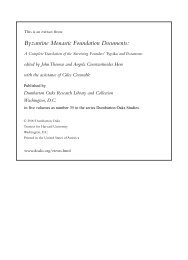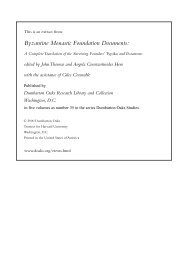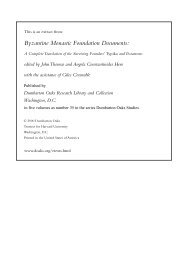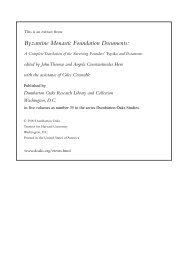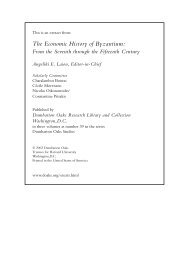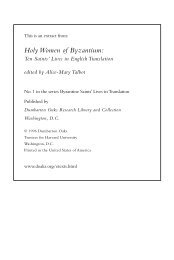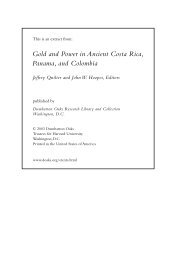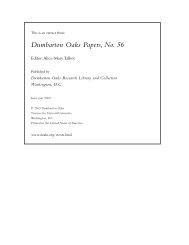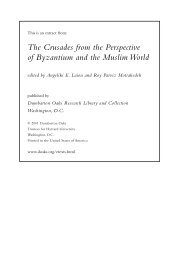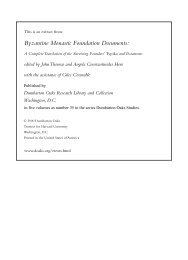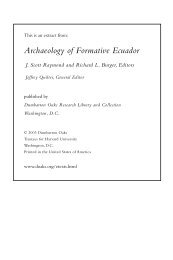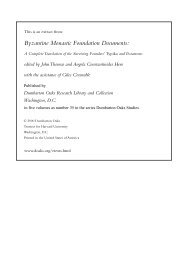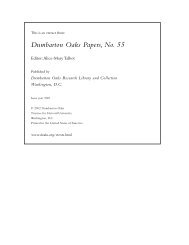Nature and Ideology: Natural Garden Design in ... - Dumbarton Oaks
Nature and Ideology: Natural Garden Design in ... - Dumbarton Oaks
Nature and Ideology: Natural Garden Design in ... - Dumbarton Oaks
You also want an ePaper? Increase the reach of your titles
YUMPU automatically turns print PDFs into web optimized ePapers that Google loves.
“TEUTONIC” TRENDS<br />
This racist idea, held by Wiepk<strong>in</strong>g <strong>and</strong> others, of a specific German feel<strong>in</strong>g for l<strong>and</strong>scape<br />
beauty <strong>and</strong> nature, <strong>and</strong> the search for national identity <strong>and</strong> for l<strong>in</strong>ks from present German society<br />
to the ancient Germanic tribes, had a considerable impact on l<strong>and</strong>scape design dur<strong>in</strong>g National<br />
Socialism. The study of prehistoric Germanic l<strong>and</strong>scapes became an important part of Wiepk<strong>in</strong>g’s<br />
curriculum. Many of his students wrote their master’s theses on related topics. One of these<br />
studies was carried out by Werner Lendholt (1912–80), who later was Wiepk<strong>in</strong>g’s successor at the<br />
University of Hannover. Wiepk<strong>in</strong>g <strong>in</strong>troduced Lendholt’s work <strong>in</strong> 1937 to the readership of the<br />
magaz<strong>in</strong>e Gartenkunst, the most <strong>in</strong>fluential l<strong>and</strong>scape architecture magaz<strong>in</strong>e <strong>in</strong> Germany at that<br />
time, as follows:<br />
Mr. Lendholt had the task of prov<strong>in</strong>g, on the basis of the large-scale map of Hohenzieritz,<br />
that our ancestors already dur<strong>in</strong>g the Bronze Age had a highly developed sense of l<strong>and</strong>scape<br />
beauty <strong>and</strong> that they were already l<strong>and</strong>scape designers. The task of Mr. Lendholt is part of<br />
the <strong>in</strong>vestigation of the entire Ur-Germanic space with regard to these aspects. His work<br />
produced wonderful confirmations. We know now that we possess an ancient culture, <strong>and</strong><br />
we know that the Germanic idea of Midgart does not belong merely to the world of<br />
myths 43 (Fig. 6).<br />
It need only be mentioned here that Lendholt did not have the task of <strong>in</strong>vestigat<strong>in</strong>g whether the<br />
ancestors of the German people “had a highly developed sense of l<strong>and</strong>scape beauty” but “the task<br />
of prov<strong>in</strong>g” it. This serves as one of numerous examples that provide evidence of Wiepk<strong>in</strong>g’s<br />
unscholarly <strong>and</strong> doctr<strong>in</strong>aire way of teach<strong>in</strong>g.<br />
These remarks may suffice to expla<strong>in</strong> the ideological background for the design of the<br />
Grove of the Saxons <strong>and</strong> the Places of the Ancestors at Hilligenloh <strong>and</strong> Seelenfeld, the sites that<br />
are discussed below.<br />
The Places of the Ancestors at Hilligenloh <strong>and</strong> Seelenfeld<br />
The Grove of the Saxons <strong>and</strong> the cemeteries of Hilligenloh <strong>and</strong> Seelenfeld are situated <strong>in</strong><br />
the northern part of Germany: the Sachsenha<strong>in</strong> near Verden on the river Aller, the Seelenfeld<br />
cemetery between M<strong>in</strong>den <strong>and</strong> Nienburg, <strong>and</strong> Hilligenloh near Oldenburg. These regions are<br />
characterized by agricultural use <strong>and</strong> heather l<strong>and</strong>scapes that conta<strong>in</strong> numerous examples of<br />
ancient Germanic burial sites. The cemeteries of Seelenfeld <strong>and</strong> Hilligenloh were laid out around<br />
1930 by members of the so-called Tannenberg League <strong>and</strong> the German People’s Parish, two<br />
volkish organizations which were closely <strong>in</strong>terwoven. The Tannenberg League was founded <strong>in</strong><br />
August 1925 by Erich Ludendorff, a “lead<strong>in</strong>g German general <strong>in</strong> the First World War (<strong>and</strong>) coleader<br />
of the Munich beer hall putsch.” 44 Ludendorff’s Tannenberg League was part of a movement<br />
that “advocated some form of national socialism which was at times more ‘volkish,’ more<br />
‘consciously German,’ more ‘national bolshevist’ than the rather vaguely def<strong>in</strong>ed nationalization<br />
plans of the NSDAP.” 45 Ludendorff’s wife Mathilde (1877–1966) established the so-called Ger-<br />
43 H. Fr. Wiepk<strong>in</strong>g-Jürgensmann, “Über die Umwelt des deutschen Volkes,” Gartenkunst 50 (1937), 2, 43.<br />
44 P. Rees, Biographical Dictionary of the Extreme Right s<strong>in</strong>ce 1890, New York, 1990, 2,238.<br />
45 Herm<strong>and</strong>, Old Dreams, 123.<br />
201




